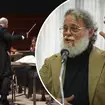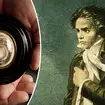Baron Pasqualati (1777 - 1830): Beethoven's landlord
Beethoven rented in wealthy patron of the arts Baron Johann Pasqualati's Vienna apartment for over a decade and wrote many of his most important works within its four walls.
Wealthy patron of the arts in Vienna, Baron Johann Pasqualati inherited a fine four-storey house on the Mölkerbastei, overlooking the Bastion and Glacis to the Vienna Woods to the west and north-west of the city.
In autumn of 1804 - a fraught year which had seen Beethoven move out of his lodgings in the Theater an der Wien after his contract was terminated, then move in with his friend Stephan von Breuning for a short period which ended when they had a serious disagreement - Beethoven's young friend and assistant, Ferdinand Ries, found him an apartment on the top floor of the house owned by Baron Pasqualati.
It consisted of two rooms with fine views over the Glacis to the Vienna Woods. To afford views to the Prater gardens in the east, Beethoven - without seeking Baron Pasqualati's permission, and much to the annoyance of the building's other tenants - had a window put in the east wall.
When Pasqualati offered a mild complaint, Beethoven retorted that the Baron should be grateful to him for improving the apartment!
Beethoven rented the apartment from autumn 1804 to spring 1815, with two breaks from autumn 1808 to the end of 1810, and from February to June 1814. He asked Pasqualati to keep the apartment available for him even when he was not there, which the Baron gladly did.
Beethoven delighted mischievously in the discomfort the four flights of stairs gave to certain of his visitors, especially the hugely overweight violinist Ignaz Schuppanzigh. The visitor today can sympathise with Schuppanzigh!
Beethoven composed many of his most important works while living in the Pasqualatihaus.
These included the Fourth, Fifth and Seventh Symphonies, Fidelio, Fourth Piano Concerto, Violin Concerto, and String Quartets op. 59 (Razumovsky) and op. 95 'Serioso'.
The apartment has been preserved and is today a Beethoven museum. It contains many artefacts and personal belongings of Beethoven, including ear trumpets, a salt and pepper shaker, and a lock of his hair.
The green door that was the door to Beethoven's apartment in his final illness in the Schwarzspanierhaus is there; on the wall alongside it hangs a copy of the painting of Beethoven's grandfather that he so treasured. (The original is in the Historisches Museum der Stadt Wien.)
In 1814 Beethoven composed an elegy (op. 118) for the third anniversary of the death of Pasqualati's wife Eleonore, and in 1815 he presented him with a canon (WoO 165) as a New Year gift. During Beethoven's final illness Pasqualati sent him several gifts of food, for which Beethoven was very grateful.


























